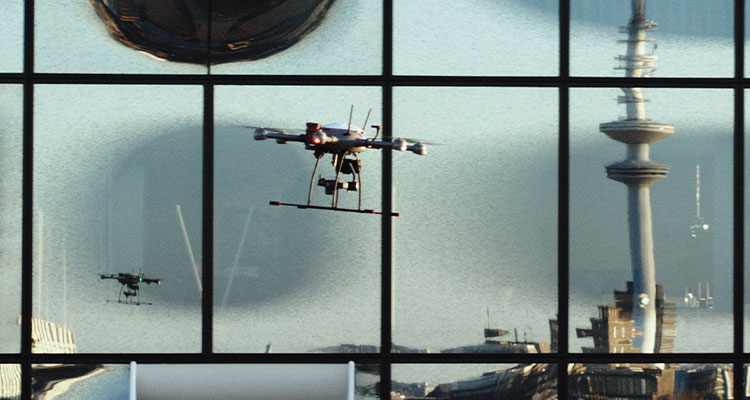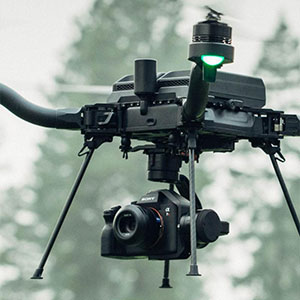How drones have become indispensable tools in the industry
Six key trends are currently shaping the construction industry, driven by the need for increased efficiency, sustainability and safety: building information modelling (BIM), 3D printing, robotics, IoT and augmented/virtual reality. In this piece we focus on how drones have come to the fore, allowing unprecedented access and monitoring.
These unmanned aerial vehicles (UAVs) have seamlessly integrated into the construction ecosystem: they are increasingly being used for site surveys, inspections, and monitoring. They provide high-resolution aerial imagery and 3D mapping capabilities, which are invaluable for assessing site conditions, tracking progress, and ensuring safety. Equipped with state-of-the-art high-resolution cameras and an extensive array of sensors, drones have assumed a pivotal role in modern construction, elevating safety, enhancing cost-efficiency, and facilitating data-driven decision-making.

The construction sector utilizes drones for two applications. Surveying drones are used prior to construction, during construction for monitoring progress and project management, and inspection drones are used after construction during the lifetime of the building or infrastructure to monitor it and anticipate renovation work.
While the role of drones is undeniably transformative, selecting the right camera to complement its capabilities in construction projects is a critical consideration. The camera serves as the lens through which the drone captures the construction site, and it must be meticulously chosen to meet the project’s specific needs, ensuring the delivery of high-quality data and images.
This article explores the essential factors that construction professionals must take into account when deciding on the camera to use in their drones. It is imperative that this choice guarantees not only optimal image quality but also maintains the drone’s aerodynamics and operational efficiency. When selecting a camera for drones used in construction, the following considerations hold significant weight:
Sensor size
The use of drones to capture images during construction projects requires precision. Consequently, the camera’s resolution is of utmost importance. However, striking the right balance between sensor size and image quality is essential. Smaller sensors with higher pixel density can provide exceptional resolution but may struggle in low-light conditions. On the other hand, larger sensors can deliver better low-light capabilities but might compromise image quality. When choosing a camera, consider how it integrates seamlessly into the drone’s design to ensure each component functions harmoniously.
Weight and flight time
As sensor size increases, so does the camera’s weight, directly impacting the drone’s flight time. The choice of camera should align with the specific flight time requirements of the construction application. For shorter flights, a more sophisticated yet heavier camera may be suitable, while longer flight times necessitate lighter camera options. Striking a balance between flight time and image quality often proves to be the most pragmatic approach. Sony’s dedicated drone camera, the ILX-LR1, at just 243g is optimized for maximum payload. Some cameras can be powered directly from the drone’s battery, offering weight savings but potentially affecting flight time.
In-flight control and automation
Camera technology has evolved significantly, introducing automation features that enhance functionality. Software development kits (SDKs), such as included in Sony’s Camera Remote Toolkit, enable precise control over various aspects of camera operation. In the context of construction imaging, this level of automation is invaluable for achieving precision in location and setting control. When selecting a camera, evaluate the specific functionality required. Does it need preset firing timings, external triggers, or GPS location integration? The choice between developing a custom application via the SDK or utilizing a companion app depends on your project’s unique needs.
Lens portfolio
Effective construction imaging frequently necessitates capturing expansive areas with a wide-angle lens. It is essential to consider the range of compatible lenses available for your chosen camera. Manufacturers like Sony offer a selection of wide-angle lenses tailored to the requirements of construction imaging, ensuring exceptional image quality.
Image processor 
Often overlooked but indispensable, the image processor acts as the camera’s brain, significantly influencing its performance. Opting for a camera where the processor has been intricately designed to synergize with other components ensures seamless functionality and superior results.
Dynamic range
Drones must deliver quality images in variable and imperfect lighting conditions. The dynamic range of your camera is pivotal, allowing you to capture excellent images in all circumstances.
Balancing multiple factors
Selecting the right camera involves a careful balancing act between these various factors. Sony, for example, is a trusted partner for numerous drone manufacturers and operators due to its range of models catering to different applications and budgets, along with a world-leading lens lineup and a highly configurable SDK.
In conclusion, choosing the ideal camera for drones used in construction is a nuanced process that depends on the specific requirements of your project. By carefully considering factors like sensor size, weight, automation, lens compatibility, image processing, and dynamic range, you can ensure that your drone is equipped with the perfect camera to capture the most precise and high-quality data for your construction project. This careful selection process ensures that your drone, with its advanced imaging capabilities, becomes an indispensable asset in the ever-evolving world of construction.
For a list of the sources used in this article, please contact the editor.
By Matthew Swinney
Matthew Swinney is Head of Image Sensing Solutions at Sony Europe. Digital Imaging Solutions focuses on bringing Sony’s established, industry-leading, advanced imaging technology to multiple applications, including but not limited to aerial imaging, inspection and surveying, photogrammetry, 3D scanning, media production and data protection. These applications find their home in many industries such as surveying, law enforcement, dentistry, agriculture, automotive, e-commerce, gaming or even archiving.

